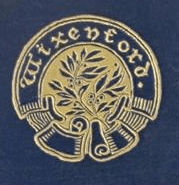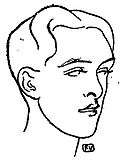Wixenford School
Coordinates: 51°24′00″N 0°49′34″W / 51.400°N 0.826°W
 | |
| Established | 1869 |
|---|---|
| Closed | 1934 |
| Type | Independent preparatory school |
| Founder | Richard Cowley Powles |
| Location |
Wokingham England |
| Gender | Boys |
| Ages | 7–13 or 14 |
Wixenford School, also known as Wixenford Preparatory School and Wixenford-Eversley, was an independent preparatory school for boys near Wokingham, founded in 1869. A feeder school for Eton, after it closed in 1934 its former buildings were taken over by the present-day Ludgrove School.
History
The school was founded in 1869 at Wixenford House, Eversley, Hampshire, by its first head master, Richard Cowley Powles (1819–1901), a Church of England clergyman, and has been described as "successful and fashionable".[1] Among the school's first intake of boys, in May 1869, was George Nathaniel Curzon, a future Viceroy of India.[2]
Before being attached to the school, "Wixenford" was the name of its first home, a new house built for Powles at Eversley in 1868–69.[3] Powles, who in his youth had been a fellow of Exeter College, Oxford, had previously operated a school at Blackheath, and he came to Eversley to be near his lifelong friend Charles Kingsley. After Kingsley's death in 1875, Powles became less active in the school and retired as headmaster in 1879. He moved to Chichester in 1881, where he became a prebendary of the cathedral.[4] One of his boys at Wixenford, Albert Baillie, writing in the 1950s, recalled Powles as "a genuine educator and a remarkable man" and noted that he had worn his hair "neatly brushed up into two horns above his ears".[5]
Powles was succeeded in 1879 by Ernest Penrose Arnold, a graduate of Balliol College, Oxford, and a nephew of Thomas Arnold of Rugby School.[6] E. P. Arnold remained as head master of the school until 1903.[7]At six feet, five inches, in height,[8] Arnold has been described by Rupert Croft-Cooke as "a kindly but rather frightening bearded man".[9] Wixenford was still small, as most such schools were at the time, and a school photograph of the early 1880s shows thirty-nine boys, plus Arnold and five other masters.[10]
The school moved to Luckley Park, Wokingham, Berkshire, in the late 19th century. Throughout its history, it had a close connection with Eton, to which many boys progressed at about the age of thirteen.[11] A few boys stayed longer, and at least one, Peter Anson, was almost fifteen when he left the school in the summer of 1904.[12]
In 1903 Arnold was succeeded by Philip Howard Morton (1857–1925), who had been a Cambridge cricketer,[13][14] and in 1910 Country Life magazine noted that he kept a private golf course at the school and that his boys played golf "vigorously" in the Easter term.[15] In 1910, Morton was joined by two joint headmasters, who were business partners, Harold Wallis and Ernest Garnett, forming a triumvirate.[16] By 1920, Morton had retired and had been replaced by Charles Mansfield, but Wallis and Garnett remained.[17] By 1924, Mansfield was acting as the sole head master,[18] with the other two men as partners. In September 1931 Garnett withdrew from the partnership.[19]
Amid the Great Depression of the 1930s, Wixenford suffered a decline in numbers and finally closed in 1934. With its demise, its former buildings presented an opportunity for another fashionable prep school, Ludgrove, until then based at Cockfosters, which moved onto the site in 1937.[20] While retaining its existing school name, Ludgrove kept "Wixenford" as the name of its new premises.
Old Wixenfordians


Old boys of the school are called Old Wixenfordians.[6] The following, in chronological order, are among the most notable.
- George Nathaniel Curzon, 1st Marquess Curzon of Kedleston (1859–1925), Viceroy of India and British Foreign Secretary[21]
- Thomas Gibson-Carmichael, 1st Baron Carmichael (1859–1926), Liberal politician and colonial administrator[22]
- Cyril Maude (1862–1951), actor-manager[23]
- Albert Victor Baillie (1864–1955), Dean of Windsor[24]
- Lord Alfred Douglas, or "Bosie" (1870–1945), poet and translator, intimate friend of Oscar Wilde[25]
- Frederick Pethick-Lawrence, 1st Baron Pethick-Lawrence (1871–1961), Labour politician, Secretary of State for India[26]
- R. C. Trevelyan (1872–1951), poet[6]
- Hugh Law (1872–1943), Irish politician[6]
- Nugent Hicks (1872–1942), Bishop of Lincoln[10]
- Sir Walter Wilson Greg (1875–1959), Shakespeare scholar[27]
- George Macaulay Trevelyan (1876–1962), historian[28]
- Arnold Wienholt (1877–1940), Australian politician[29]
- Edmund Parker, 4th Earl of Morley (1877–1951), soldier and landowner[30]
- Sir Howard Kennard (1878–1955), British diplomat[31]
- William Leveson-Gower, 4th Earl Granville (1880–1953), admiral[32]
- Sir Stewart Gore-Browne (1883–1967), settler and politician in Northern Rhodesia[33]
- Ralph Glyn, 1st Baron Glyn (1884–1960), soldier and Conservative politician[34]
- Peter Anson (1889–1975), monk, writer, and artist[12]
- Duff Cooper, 1st Viscount Norwich (1890–1954), Conservative politician and diplomat[35]
- William Howard, 8th Earl of Wicklow (1902–1978), clergyman, writer and translator[36]
- Sir Edmund Bacon, 13th Baronet, KG (1903–1982), landowner and Lord Lieutenant of Norfolk[37]
- Kenneth Clark (1903–1983), art historian[38]
- Prince Charles, Count of Flanders (1903–1983)
- Alfred Duggan (1903–1964), historical novelist[39]
- Hubert Duggan (1904–1943), Conservative politician[39]
- James Stern (1904–1993), Anglo-Irish writer[40]
- Sir Harold Acton (1904–1994), historian[41]
- Edward Ward, 7th Viscount Bangor (1905–1993), BBC war correspondent and author[42]
- David Herbert (1908–1995), socialite, memoirist and interior decorator
- Sir Frederick Warner (1918–1995), diplomat[43]
- William Whitelaw, 1st Viscount Whitelaw, (1918–1999), Home Secretary
- Henry Paget, 7th Marquess of Anglesey (1922–2013), author and peer[44]
Notes
- ↑ Donald P. Leinster-Mackay, The Rise of the English Prep School (1984), p. 141: "Cowley Powles' school, Wixenford, was successful and fashionable."
- ↑ Kenneth Rose, Curzon, a Most Superior Person: a Biography (1985), p. 22
- ↑ William White, ed. History, Gazetteer and Directory of the County of Hampshire (1878), p. 230: "WIXENFORD, a large and handsome mansion, erected in 1868-9, is the residence of the Rev. R. Cowley Powles, M.A."
- ↑ Powles, Richard Cowley (1819–1901) at utoronto.ca, accessed 4 September 2013
- ↑ Albert Baillie, My First Eighty Years (1951), p. 24: "Powles... wore his hair neatly brushed up into two horns above his ears — a fashion you can see in Cruikshank's illustrations of Dickens — and from time to time he would stroke those horns with his fingers."
- 1 2 3 4 Frederick Pethick-Lawrence, 1st Baron Pethick-Lawrence, Fate Has Been Kind (1943), p. 20
- ↑ The Balliol College Register, 1833–1933 (Balliol College, 1934), p. 49
- ↑ Pethick-Lawrence (1943), p. 21
- ↑ Rupert Croft-Cooke, Bosie: the Story of Lord Alfred Douglas, his Friends and Enemies (Bobbs-Merrill Co., Inc., 1963), p. 33: "Bosie was removed and sent to Wixenford, which was under a kindly but rather frightening bearded man called Arnold, who found him — as he certainly was — a spoilt child..."
- 1 2 Maurice Francis Headlam, Bishop and friend: Nugent Hicks, sixty-fourth bishop of Lincoln (1945), p. 17
- ↑ Ion Trewin, Alan Clark: The Biography (2009), chapter 2, 'Early Memories': "St Cyprian's, like Wixenford, also operated principally as a feeder to public schools, Eton by preference".
- 1 2 'Anson, Peter Frederick', in Oxford Dictionary of National Biography (OUP, 2007)
- ↑ The Journal of Education, vol. 57 (1925), p. 372
- ↑ 'Mr. P. H. Morton' (obituary) in The Times dated 18 May 1925, p. 21; the Deaths column in The Times, issue 43963 dated 16 May 1925, p. 1, reports the death of Philip Howard Morton of Hoe Farm, Hascombe, Godalming, late of Wixenford, on 13 May 1925, aged 67.
- ↑ Country Life, vol. 28 (1910), p. 984
- ↑ Meryle Secrest, Kenneth Clark: a Biography (1985), p. 31
- ↑ 'Naval Cadetships' in The Times, issue 42473 dated 27 July 1920; p. 4
- ↑ 'School Scholarships' in The Times, issue 43603 dated 18 March 1924, p. 16
- ↑ 'From The London Gazette; in The Times, issue 45920 dated 5 September 1931, p. 16
- ↑ Leinster-Mackay (1984), p. 154: "In 1937 Ludgrove moved from Cockfosters to buildings in Wokingham vacated by Wixenford School, which had become defunct in 1934 through lack of clientele."
- ↑ Philip Holden, Autobiography and Decolonization: Modernity, Masculinity, and the Nation-state (2008), p. 46
- ↑ Katherine Prior, 'Carmichael, Thomas David Gibson, Baron Carmichael (1859–1926)', in Oxford Dictionary of National Biography (Oxford University Press, 2004); online biography at oxforddnb.com, May 2006, accessed 4 September 2013 (subscription required)
- ↑ Austin Brereton, Cyril Maude: a Memoir (1914), p. 10
- ↑ Albert Victor Baillie, My First Eighty Years (1951), p. 24
- ↑ Rupert Croft-Cooke, Bosie: The Story of Lord Alfred Douglas, His Friends and Enemies (1963), p. 33
- ↑ Brian Harrison, ‘Lawrence, Frederick William Pethick-, Baron Pethick-Lawrence (1871–1961)’, in Oxford Dictionary of National Biography, Oxford University Press, 2004; online biography at oxforddnb.com, January 2011, accessed 4 September 2013 (subscription required)
- ↑ Walter Wilson Greg, ed. Joseph Rosenblum, Sir Walter Wilson Greg: a collection of his writings (1998), p. 2
- ↑ G. M. Trevelyan, An Autobiography & Other Essays (1949), p. 10
- ↑ Rosamond Siemon, The Eccentric Mr Wienholt (2005), p. 267
- ↑ Vyvyen Brendon, Prep School Children: a Class Apart over Two Centuries (2009), p. 63
- ↑ Frank C. Roberts, ed., Obituaries from the Times (1951), p. 410
- ↑ World Biography, vol. 1 (1948), p. 2052
- ↑ A. D. Roberts, 'Browne, Sir Stewart Gore-(1883–1967)', in Oxford Dictionary of National Biography, Oxford University Press, 2004; online biography at oxforddnb.com, accessed 4 September 2013 (subscription required)
- ↑ 'Glyn, 1st Baron', in Who Was Who 1951–1960 (A. & C. Black, 1984 reprint, ISBN 0-7136-2598-8)
- ↑ Duff Cooper, Old Men Forget (1953), p. 31
- ↑ 'Osborne Passing-In List' in The Times, issue 41129 dated 31 March 1916, p. 5
- ↑ Old Public School Boy's Who's Who (St James Press, 1933), p. 26
- ↑ Meryle Secrest, Kenneth Clark: A Biography (1985), p. 31
- 1 2 Grace Curzon, Marchioness Curzon of Kedleston, Reminiscences (1955), p. 45
- ↑ Wystan Hugh Auden, ed. Katherine Bucknell, In Solitude, for Company: W. H. Auden after 1940, Unpublished Prose (1995), p. 36
- ↑ Evelyn Waugh, The Essays, Articles and Reviews of Evelyn Waugh (Methuen, 1983), p. 17
- ↑ Edward Ward, Number One Boy (1969), p. 17
- ↑ ‘WARNER, Sir Frederick Archibald (Sir Fred)’, in Who Was Who 1991–1995 (London: A. & C. Black, 1996, ISBN 0-7136-4496-6)
- ↑ Andrew Cox, Charles Roger Dod, Robert Phipps Dod, Dod's Parliamentary Companion (1999), p. 12